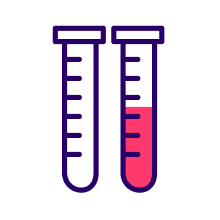
Diagnosing PNH

Paroxysmal nocturnal haemoglobinuria (PNH) can be difficult to suspect because it is a rare disease and has a range of symptoms that are similar to those of other diseases, including fatigue, breathlessness, anaemia and abdominal pain.1,2
Doctors will assess a patient’s symptoms and perform a number of different tests to exclude the possibility of other diseases and to confirm the diagnosis of PNH.
Doctors will assess a patient’s symptoms and perform a number of different tests to exclude the possibility of other diseases and to confirm the diagnosis of PNH.
The diagnosis of PNH can be confirmed by a specialised laboratory test, called high sensitivity flow cytometry, which detects the percentage of PNH blood cells that lack the protective anchored proteins.1,3
Other laboratory tests that may be used to confirm a diagnosis of PNH include:
Other laboratory tests that may be used to confirm a diagnosis of PNH include:




After undergoing testing, patients will need to discuss the results of their diagnostic tests as well as next steps with their healthcare professionals.